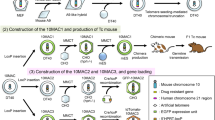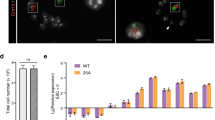Abstract
This article summarizes our efforts to use chromosome-based vectors for animal transgenesis, which may have a benefit for overcoming the size constraints of cloned transgenes in conventional techniques. Since the initial trial for introducing naturally occurring human chromosome fragments (hCFs) with large and complex immunogulobulin (Ig) loci into mice we have obtained several lines of trans-chromosomic (Tc) mice with transmittable hCFs. As expected the normal tissue-specific expression of introduced human genes was reproduced in them by inclusion of essential remote regulatory elements. Recent development of ‘chromosome cloning’ technique that enable construction of human artificial chromosomes (HACs) containing a defined chromosomal region should prevent the introduction of additional genes other than genes of interest and thus enhance the utility of chromosome vector system. Using this technique a panel of HACs harboring inserts ranging in size from 1.5 to 10 Mb from three human chromosomes (hChr2, 7, 22) has been constructed. Tc animals containing the HACs may be valuable not only as a powerful tool for functional genomics but also as an in vivo model to study therapeutic gene delivery by HACs.
This is a preview of subscription content, access via your institution
Access options
Subscribe to this journal
Receive 12 print issues and online access
$259.00 per year
only $21.58 per issue
Buy this article
- Purchase on Springer Link
- Instant access to full article PDF
Prices may be subject to local taxes which are calculated during checkout





Similar content being viewed by others
References
Tomizuka K et al. Functional expression and germline transmission of a human chromosome fragment in chimaeric mice Nature Genet 1997 16: 133–143
Tomizuka K et al. Double trans-chromosomic mice: maintenance of two individual human chromosome fragments containing Ig heavy and kappa loci and expression of fully human antibodies Proc Natl Acad Sci USA 2000 97: 722–727
Garrick D, Fiering S, Martin DI, Whitelaw E . Repeat-induced gene silencing in mammals Nature Genet 1998 18: 56–59
Grimes B, Cooke H . Engineering mammalian chromosomes Hum Mol Genet 1998 7: 1635–1640
Brown WRA, Mee PJ, Shen MH . Artificial chromosomes: ideal vectors? Trends Biochem 2000 18: 218–223
Kuroiwa Y et al. Manipulation of human minichromosomes to carry greater than megabase-sized chromosome inserts Nature Biotechnol 2000 18: 1086–1090
International Human Genome Sequencing Consortium. A physical map of the human genome Nature 2001 409: 860–921
Kuroiwa Y et al. Efficient modification of a human chromosome by telomere-directed truncation in high homologous recombination-proficient chicken DT40 cells Nucleic Acids Res 1998 26: 3447–3448
Shinohara T et al. Mice containing a human chromosome 21 model behavioral impairment and cardiac anomalies of Down's syndrome Hum Mol Genet 2000 10: 1163–1175
Kazuki Y et al. Germline transmission of a transferred human chromosome 21 fragment in transchromosomal mice J Hum Genet 2001 46: 600–603
Shen MH et al. Human mini-chromosomes in mouse embryonal stem cells Hum Mol Genet 1997 6: 1375–1382
Shinohara T et al. Stability of transferred human chromosome fragments in cultured cells and in mice Chromosome Res 2000 8: 713–725
Smith AJH et al. A site-directed chromosomal translocation induced in embryonic stem cells by Cre-loxP recombination Nature Genet 1995 9: 376–384
Dieken ES et al. Efficient modification of human chromosomal alleles using recombination-proficient chicken/human microcell hybrids Nature Genet 1996 12: 174–182
Dunnen JTD et al. Recombination of the 2.4 Mb human DMD-gene by homologous YAC recombination Hum Mol Genet 1992 1: 19–28
Ryder-Cook AS et al. Localization of the mdx mutation within the mouse dystrophin gene EMBO J 1988 7: 3017–3021
Acknowledgements
We wish to thank S Tanaka, S Igami, T Ishihara, M Shionoya for excellent technical assistance. We also thank K Hanaoka and M Hayasaka for technical advice and valuable discussions.
Author information
Authors and Affiliations
Rights and permissions
About this article
Cite this article
Kuroiwa, Y., Yoshida, H., Ohshima, T. et al. The use of chromosome-based vectors for animal transgenesis. Gene Ther 9, 708–712 (2002). https://doi.org/10.1038/sj.gt.3301754
Published:
Issue Date:
DOI: https://doi.org/10.1038/sj.gt.3301754
Keywords
This article is cited by
-
Human Antibody Production in Transgenic Animals
Archivum Immunologiae et Therapiae Experimentalis (2015)
-
Artificial chromosome formation in maize (Zea mays L.)
Chromosoma (2009)
-
Introduction of a CD40L genomic fragment via a human artificial chromosome vector permits cell-type-specific gene expression and induces immunoglobulin secretion
Journal of Human Genetics (2008)



